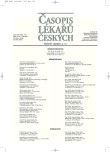-
Medical journals
- Career
Analyse of Results of Percutaneous Nephrolithotomies
Authors: P. Macek; K. Novák; T. Hanuš; M. Babjuk; Martin Pešl; L. Šafařík; K. Fógel; V. Soukup; J. Dvořáček; J. Sedláček; K. Fógel; J. Stolz; O. Čapoun
Authors‘ workplace: Urologická klinika 1. LF UK a VFN, Praha
Published in: Čas. Lék. čes. 2007; 146: 809-812
Category: Original Article
Overview
Background.
Percutaneous nephrolithotomy is an effective less invasive method for the treatment of nephrolithiasis. Authors retrospectively analysed results of this procedure performed in a single centre (Department of Urology, General University Hospital, Prague) from January 2005 till June 2007.Methods and Results.
Patients were acquired by an analysis of operating reports performed over a period January 2005 till June 2007 and subsequently a retrospective analysis of electronic and paper patient’s records was carried out. Percutaneous nephrolithotomy was performed in 150 patients. Of those, 117 (78 %) patients underwent primary and 33 (21,3 %) secondary procedure. Analysed group consisted of 85 (56,7 %) men and 65 (43,3 %) women. Right-sided procedure was performed in 46 % (69 times) and left-sided in 54% (81 times) of cases. Mean patient’s age was 52,9 years (SD ± 16,3). Mean stone size was 18,3 (SD ± 9,5) mm. Staghorn calculi were present in 19 (12,7 %) patients and 77 (51,3 %) patients had more than 1 stone. Intracorporeal lithotripsy was necessary in 82 (54,7 %) cases. Seventy eight (52 9 %) patients were stone free after the procedure. There were 24 (16 %) patients with an anatomic abnormality of upper urinary tract. The most common (in 64,3 %) component in analysed stones was a calcium oxalate.Conclusions.
The amount of stone free patients is rather lower compared to the literature results. However, definitive results are always affected by auxiliary procedures (mainly extracorporeal shock wave lithotripsy), which are not included in the analysis.Key words:
percutaneous nephrolithotomy, lithiasis, lithotripsy.
Labels
Addictology Allergology and clinical immunology Angiology Audiology Clinical biochemistry Dermatology & STDs Paediatric gastroenterology Paediatric surgery Paediatric cardiology Paediatric neurology Paediatric ENT Paediatric psychiatry Paediatric rheumatology Diabetology Pharmacy Vascular surgery Pain management Dental Hygienist
Article was published inJournal of Czech Physicians

-
All articles in this issue
- New Aspects in Prostate Cancer Therapy
- Radical Cystectomy in the Treatment for Bladder Carcinoma: Results of 125 Operated Patients
- Cystectomy in the Treatment of Bladder Cancer
- Laparoscopic Radical Nephrectomy – The Cohort of 150 Patients
- Carcinoma of the Penis
- Controversial Opinions in the Prostate Cancer Treatment
- Comparison of the Efficacy of ESWL and Ureteroscopy in the Treatment of Lower Ureteric Stone
- Long-term Results of Uretroplastic Operations Using Buccal Mucosa in Different Modifications
- Detection of Prostate Cancer by Ultrasonographically-guided Transrectal Prostate Biopsies at the Department of Urology of the First Faculty of Medicine, Charles University and General Teaching Hospital in Prague, Analysis of 1464 Cases
- Evaluation of the Tumor Extension Before Planned Radical Prostatectomy: A Prospective Study
- Painful Bladder Syndrome in Interstitial cystitis: Relation Between Symptoms, Endoscopy and Biopsia Results and the Treatment Effects
- Progress of Laparoscopic Surgery in Adults at the Department of Urology of the First Faculty of Medicine and General Teaching Hospital
- Analyse of Results of Percutaneous Nephrolithotomies
- Conservative Treatment of the Traumatic Neurogenic Bladder Dysfunction
- Endoscopic and Conservative Treatment of Vesicoureteric Reflux
- Microsurgical Subinguinal Varicocelectomy in Children and Adolescents
- Journal of Czech Physicians
- Journal archive
- Current issue
- Online only
- About the journal
Most read in this issue- Painful Bladder Syndrome in Interstitial cystitis: Relation Between Symptoms, Endoscopy and Biopsia Results and the Treatment Effects
- Microsurgical Subinguinal Varicocelectomy in Children and Adolescents
- Long-term Results of Uretroplastic Operations Using Buccal Mucosa in Different Modifications
- Radical Cystectomy in the Treatment for Bladder Carcinoma: Results of 125 Operated Patients
Login#ADS_BOTTOM_SCRIPTS#Forgotten passwordEnter the email address that you registered with. We will send you instructions on how to set a new password.
- Career

